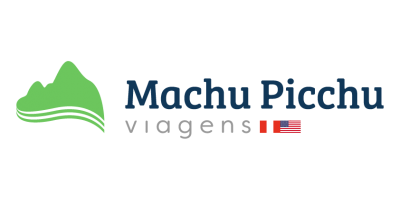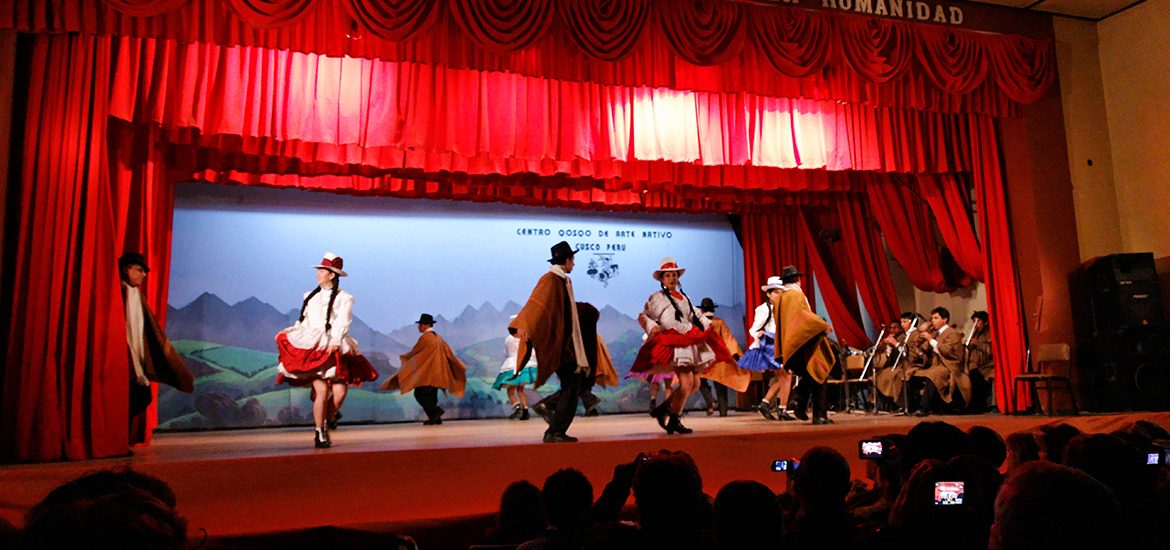Musical instruments, traditional costumes, and traditional dances join in the “Centro Qosqo de Arte Nativo” (CQAN), where you can see music and dance shows performed by skillful Cusco performers. On your visit to Cusco, this is a must as the show is one of the main attractions to get involved in dances and music from the Andes. Let’s explore the history and importance of this place, along with the dances and performances you can see here. Let’s dive in.
History and tradition
The Qosqo Native Art Center has celebrated Peru’s culture since 1924. It aims to preserve folk dances and music from Cusco and other Andean areas. Currently, this center showcases 50 dances and 100 songs, all of them native to the Cusco region, along with traditional costumes and musical instruments.
With approximately 70 artists, CQAN has performed in festivals across South America and Europe, you can also have CD and DVD copies of their performances. The center also has a museum with traditional costumes and instruments.
Some of CQAN’s traditional dances
Awqa Chileno
The Awqa Chileno dance beautifully showcases the rich history of indigenous peoples and their interactions with Chilean invaders. This dance, with roots in the War of the Pacific, features performers in colorful warrior costumes.
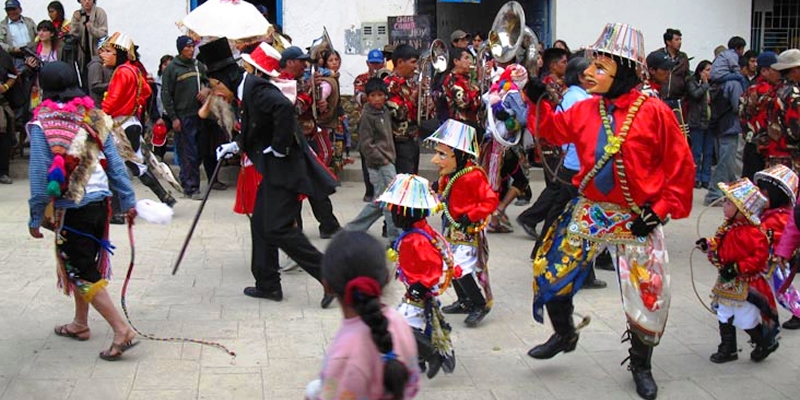
Their vibrant headdresses and masks represent strength and courage. The word “Awqa,” meaning “enemy” in Quechua, highlights the spirit of resistance and pride in Peruvian identity. The choreography includes lively movements, reflecting the challenges faced by these communities.
The gestures and rhythmic stomping symbolize their fight for territory and cultural heritage. With lively music from traditional instruments, the dance blends emotions. It celebrates ancestors’ bravery and remembers their struggles.
Contradanza
Contradanza, a traditional Cusqueño dance, blends Spanish colonial influences with Andean culture. The dance at religious and cultural festivities is a vibrant expression of Peru’s rich heritage. It features beautiful costumes, like embroidered jackets, skirts, and feathered hats that add to its charm.
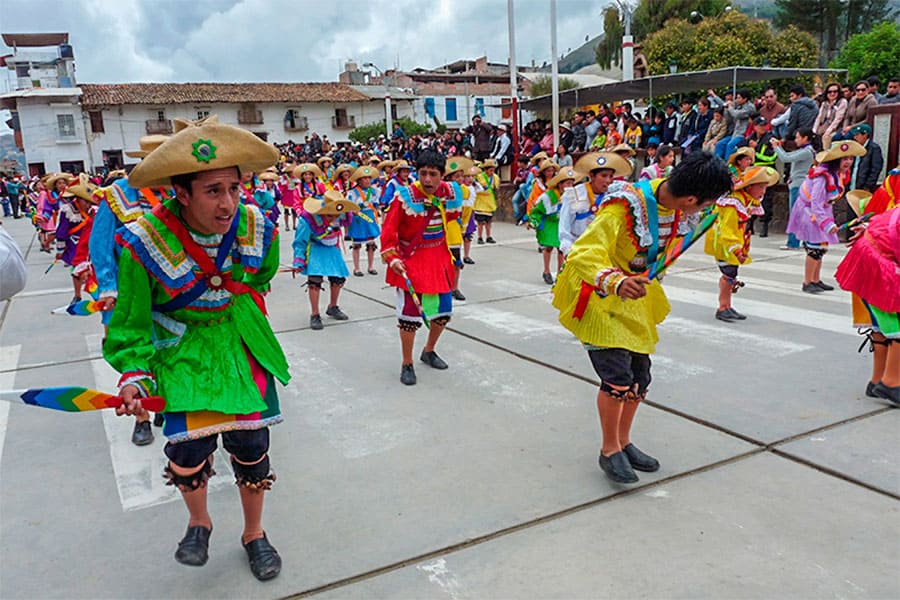
This lively dance playfully critiques social hierarchies and colonial history, often humorously portraying Spanish aristocrats. The choreography is graceful, dancers move in sync, with precise footwork and engaging partner exchanges.
The music for Contradanza blends both Andean and European instruments, creating a delightful mix of melodies. This dance shows the culture’s strength and adaptability and highlights the unique blend of indigenous and Spanish traditions in Peru.
Chujchu
Chujchu is a humorous, satirical dance performed during Cusco’s festivals. It reflects the arrival of the Spanish conquistadors and their impact on the indigenous people. The term “Chujchu” refers to the shivering caused by illness, especially malaria, which Spanish miners brought to the Andes.
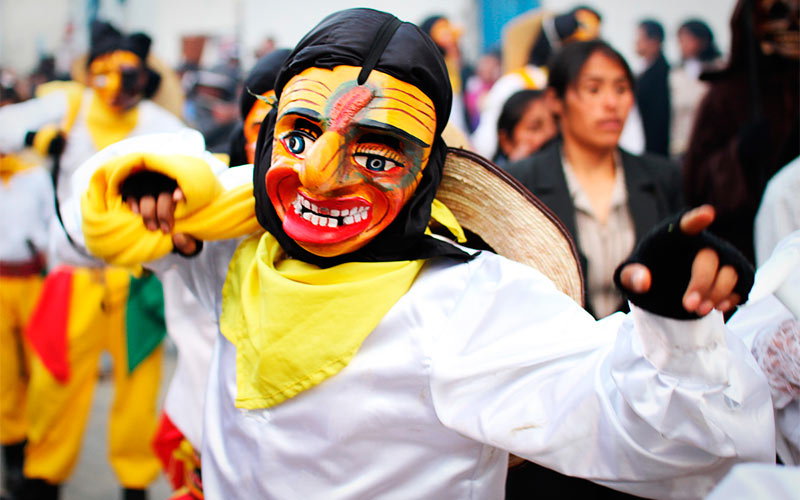
Dancers wear exaggerated costumes. These include ragged clothes, white masks, and props like bottles to symbolize medicine. Their erratic movements mimic trembling and illness, combining humor with social commentary.
The dance is lively, but its theme is dark. It criticizes the exploitation and disease brought by colonization. Chujchu serves as a reminder of historical resilience.
Majeños
The Majeños dance portrays the lives of traders from Majes Valley in Arequipa who traveled to Cusco with goods such as pisco and wine during colonial times. Performers wear wide-brimmed hats, scarves, and elegant coats reminiscent of Spanish merchants.
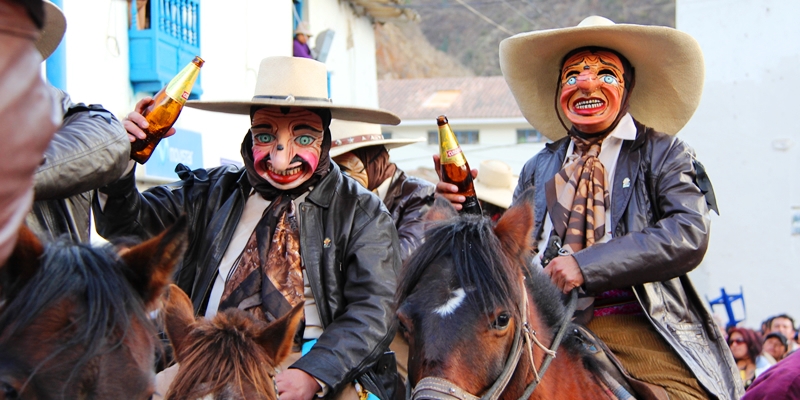
The dance celebrates their lively, boisterous natures featuring spirited movements, stamping, and playful interactions. The Majeños dancers often carry props like bottles to represent their trade. This dance is performed during festivals, reflecting both the economic exchanges and cultural interactions of the colonial era.
Saqra
Saqra, which means “devil” is a lively and playful dance that shines during religious festivals in Cusco, mixing Andean and Christian traditions. It brings to life the Andean idea of devils or mischievous spirits. Dancers wear fun devil masks with big features and colorful costumes, often using props that show their playful tricks.
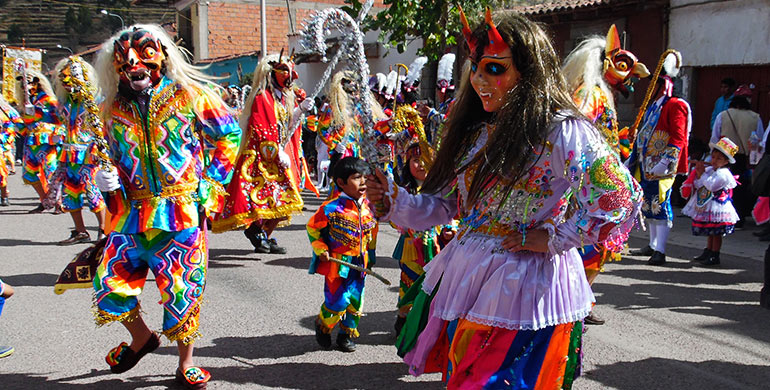
The dance shows the ups and downs of life, with performers engaging in amusing antics and energetic movements. Saqra has a devilish theme, however, it shares key moral lessons. The cheerful music and funny interactions delight the audience.
Sijlla
Sijlla is a satirical dance that mocks the excesses and arrogance of colonial-era Spanish officials and elites. During traditional festivities, the dancers wear flamboyant, over-the-top costumes. Sijlla’s choreography involves exaggerated, humorous movements that caricature arrogance and self-importance.
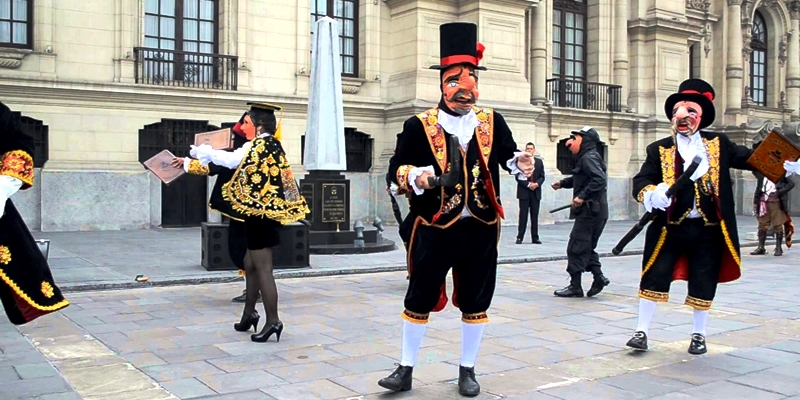
The Sijlla dance serves as a form of social commentary, using humor to critique inequality and privilege. The performance, with lively Andean music, engages audiences, telling a critical story of Cusco’s colonial history. It is both a form of entertainment and a vehicle for cultural reflection on social dynamics.
El Carnaval de Amphay
El Carnaval de Amphay is a joyful dance performed during the Carnival season. The dance celebrates love, fertility, and unity. Dancers wear bright costumes with ribbons and flowers that symbolize joy and celebration. The choreography involves lively, circular movements and partner exchanges, reflecting themes of courtship and harmony.
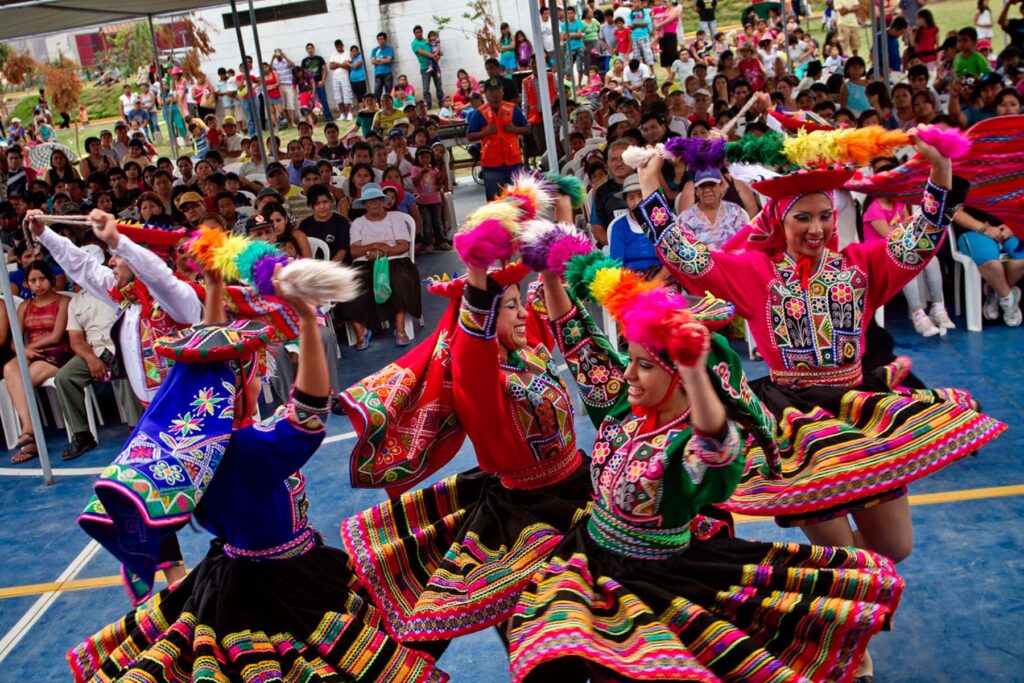
The dance is accompanied by traditional music played on charangos, flutes, and drums. It often includes playful interactions, such as spraying water or throwing confetti, adding to the festive atmosphere. El Carnaval de Amphay is a cherished tradition that strengthens community bonds.
Qorilazo
The Qorilazo dance is a joyful celebration of the cowboy culture that you can find in the Andean highlands of Cusco, in a town called Santo Tomas. Its name comes from “qori,” meaning gold, and “lazo,” which means whip.
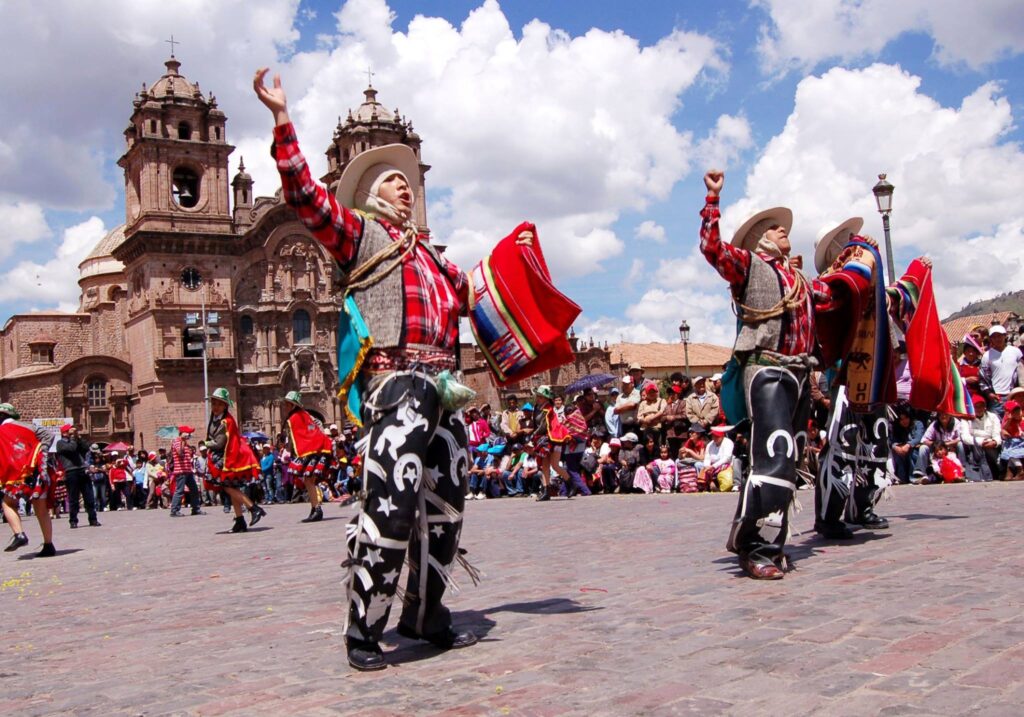
This dance beautifully showcases the lives of skilled horsemen who cared for cattle and protected the large haciendas in their region. Performers wear colorful traditional ponchos, stylish leather hats, and sturdy boots, which reflect the strength and independence of these Andean cowboys.
The choreography is lively and fun, often featuring playful lassoing moves and gestures that mimic riding horses. With its upbeat music, Qorilazo highlights the pride and creativity of the Andean people. It is a wonderful tribute to their deep connection with the land and their resilient spirit.
Los Jilgueros
“Los Jilgueros,” or “The Warblers,” is a joyful dance that highlights the special connection between people and nature, especially the lovely sounds of birdsong. Dancers wear colorful costumes that resemble birds, with beautiful embroidery and feather-like details.
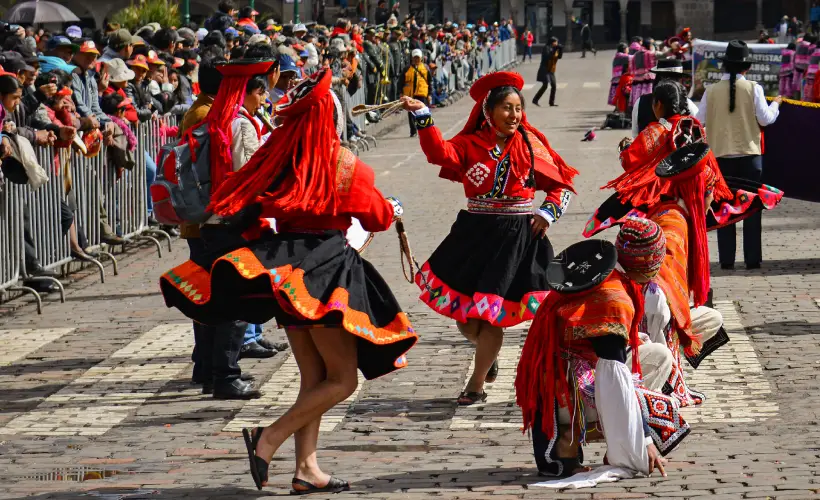
The movements are smooth and graceful, reflecting how birds fly and sing. This dance celebrates the rich variety of life and the deep respect the Andean people have for the natural world. The music, often featuring traditional flutes and strings, adds to the peaceful and uplifting feeling of the performance.
Traditional Cusco Music
Cusco traditional music carries influences and tones brought from abroad, but if we talk about completely traditional music, we’ll find that these songs no longer exist in their original form. The Incas were masters of music, inheriting many customs and traditions from other kingdoms and lands over time.
However, they had no written language and therefore no system to preserve their songs, so the Incas passed down the songs orally from generation to generation. Inca rhythms were adapted to convert the locals to Catholicism, so, songs that once worshiped the sun were replaced by church music dedicated to Catholic figures.
The Inca empire’s melodies became hymns for heaven. So far, there are 10 audio albums of Cusco’s traditional music. When you get there, we suggest arriving a bit early to grab the best seats near the stage. This way, you’ll get to enjoy the dances, the costumes, and the musical ensemble up close.
You can look forward to nearly 50 different types of dances, all performed by talented artists you’ll surely admire. The Costumes are colorful outfits that really make the dances pop! You’ll see ponchos, flared skirts, embellished trousers, straw hats, and traditional Andean caps that will surely catch your eye and match the lively music.
FAQs
Where is located the Qosqo Native Art Center?
You can find it in the heart of Cusco’s historic center, located on Avenida El Sol 872.
When is Centro Qosqo de Arte Nativo open?
The center is open every day, including weekends and holidays from 18:30 to 20:00.
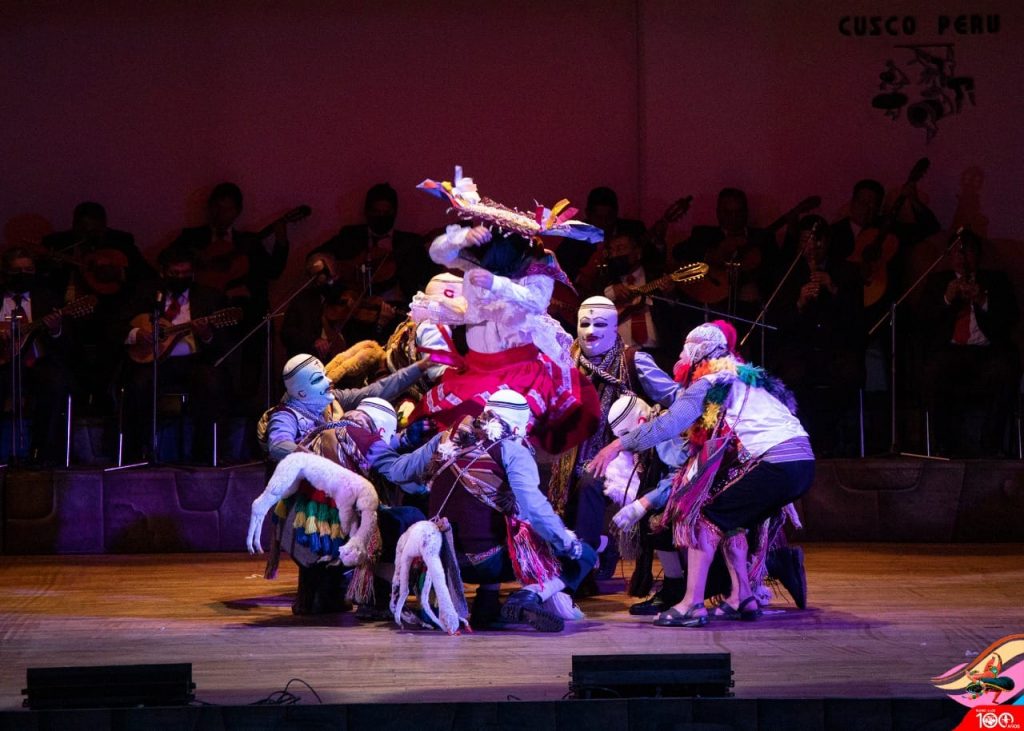
Do I need to book in advance?
You can book your sit in advance, however, you must buy your ticket directly at the theatre before the show starts.
How much are the tickets?
The fare for foreign tourists is around 30 soles ($ 10.00) `per person, 15 soles per foreign student, and 15 soles for Cuscoo people. Howeer, you can get in if you have a Cusco tourist ticket.
We hope you can enjoy the culture and traditions we have in Cusco, the city “navel of the world.” Remember that Viagens Machu Picchu offers tours and trips in the Andes, Cusco, and more. On our packages, you can get the Cusco tourist ticket to visit the Native Art Center. Contact us, so you can take your first step to learn more about the ancient Inca land! Peru and Cusco are waiting for you!
Viagens Machu Picchu, journeys that inspire, moments that last.
